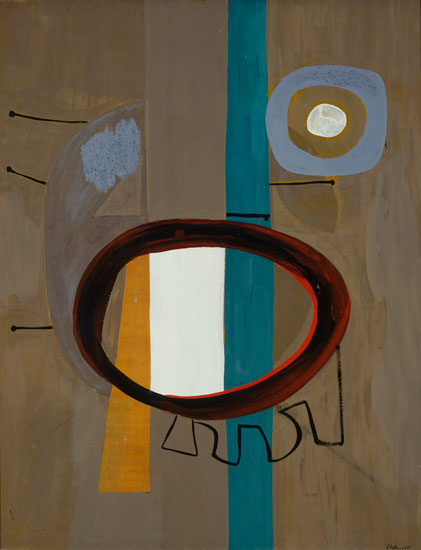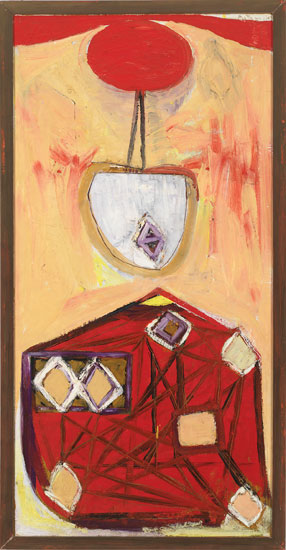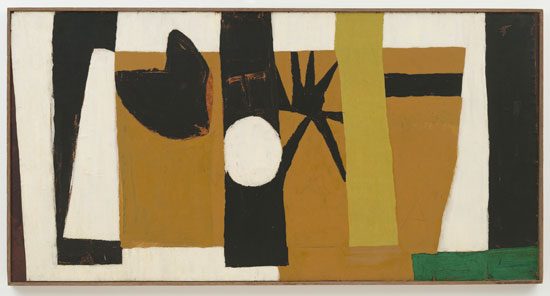Though aligned with the Abstract Expressionist painters, Robert Motherwell—whose work is on view in “Robert Motherwell: The East Hampton Years, 1944-1952” at Guild Hall through October 13—doesn’t fit into easy categorization.
A philosopher, writer, and the self-declared spokesperson of the movement, Motherwell came from an affluent background. Unlike Mark Rothko, Jackson Pollock, Willem de Kooning and Franz Kline, he was already extremely well educated in art history when he landed in New York in 1939. Raised in a household where his mother collected French antiques and his father took him on the European tour, he graduated from Stanford and attended Harvard and then Columbia, where he studied with Meyer Schapiro.
Fluent in French, Motherwell immediately befriended the European émigré Surrealists who had washed ashore due to the war. He was the link and connector between their use of “automation” (an improvisatory technique of freeing the imagination and subconscious by drawing or pasting randomly on the canvas then rearranging) and the gestural abstractions that reached their zenith in the work of Jackson Pollock’s spatter paintings. Motherwell was also among the first artists to embrace collage as a tool to bring spontaneity to his work.
Whether it’s because art historians have been put off by his urbane and privileged background, or have opted to focus on his famous series of paintings, Elegies to the Spanish Republic, the fact remains that Motherwell’s early work and his evolution from surrealist vocabulary to the subdued abstract expression he later embraced has been largely ignored.
“Robert Motherwell: The East Hampton Years, 1944-1952,” curated by Phyllis Tuchman, seeks to fill in the gaps of this important omission. Tuchman is interested in exploring Motherwell’s development before history so thoroughly codified him—in an immortalization he nourished in his own writings. And though one can argue whether the cultured Motherwell was a true expressionist, make no mistake, all his life, he endeavored to show the experience of making a picture, rather than a thing itself.
For Motherwell, perhaps more than for any other artist of this period, Abstract Expressionism was an act of enormous renunciation. His often large, simple shapes have an elegant, classical feel that belies their intuitive process. Versed in academia, Motherwell had touchstones and influences that he needed to assimilate and release before he could arrive at what he considered the essence of painting: work that showed, without the props of still life or landscape, a true state of feeling.
This process of uncovering the core was just beginning when Motherwell bought his property and built his home and studio in East Hampton, N.Y. in 1945. Photographs and a model of this studio on Georgica Road are on view at the Guild Hall exhibit and are not to be missed. They display the intricate attention to detail that Motherwell applied to all his endeavors. Perhaps because his budget allowed for it, Motherwell was one of the first artists to venture out here and to grant himself the time and the space to explore and experiment on his own.
For In Beige With Sand, done in 1945, Motherwell works with simple, natural shapes and a palette of brown, gold and blue earth and sea tones. Sand is embedded into the paint near the top of the canvas. By this time, Motherwell had already begun making collages under the tutelage of Roberto Matta and shown them to critical acclaim at Peggy Guggenheim’s gallery. In this work, the effects of that medium are visible. Instead of cutting and gluing pieces of paper, here Motherwell has begun to assemble shapes, circles and lines that could represent sea life or a purer geometry.
.

"In Beige with Sand" by Robert Motherwell, 1945. Oil on cardboard with sand and wood veneer collage, 44 7/8 x 35 inches. St Louis Art Museum, Gift of Mr. and Mrs. Joseph Pulitzer Jr. ©VAGA, NY.
.
Two years later, when he painted the more resolved The Red Skirt, he was ensconced and working in his newly designed studio in East Hampton. In this vivid red and white celebration of his marriage to his first wife, the beautiful Mexican actress Maria Emilia Ferreira y Moyers, the small round circle of her head hovers over the white mid section and the large red triangular shape of her billowing wedding skirt.
Though the painting is completely abstract and one would never know it was a wedding image without the title, the whole picture has the frontal feel, proportions and contrasts of a portrait by Goya.
.

"The Red Skirt" by Robert Motherwell, 1947. From the Series, "Personages." Oil on composition board, 48 x 24 inches. Whitney Museum of American Art, New York. ©VAGA, NY.
.
By 1947, Motherwell’s passion for the influences and heritage of Europe had nearly coalesced. Though the shapes and colors have a cool elegance, Ulysses, painted over the course of three years, is a fierce painting. The figure’s raised fist and open mouth could depict anger or humor.
Done as a tribute to the writer James Joyce, who also experimented with free association and stream of consciousness in his writing, in this piece the body of Ulysses resembles a triangular sail floating over a dark blue sea and foreshadows Motherwell’s focus on the aftermath of war.
.

"Ulysses" by Robert Motherwell, 1947 - 51. Oil on board, 37 1/2 x 29 1/2 inches. Montclair Art Museum, Museum Purchase; National Endowment for the Arts Museum Purchase Plan. ©VAGA, NY.
.
A year later, in 1948, Motherwell painted the first of his elegies, At Five in the Afternoon. Like many of his works, the title refers to a poem, this one by Federico García Lorca memorializing the death of a bullfighter. With its contrasting shapes and black and white colors, this small painting represents Motherwell’s demarcation point.
Frank O’Hara, who curated the Motherwell retrospective at MoMA in 1965, said that Motherwell tended to focus on a small body of forms. And this becomes evident in At Five in the Afternoon and in later works. Here, all Motherwell’s passions have come together in one image: literature, paint, history, simple shapes, an elegance of structure and the references to life and to death. The painting, with its vertical black columns, recalls the calligraphic drawing first inspired by Lorca’s poem.
Later, Motherwell realized that he had more to say on this subject, that it was in fact a series of archetypal motifs lamenting not just the extinction of one matador, but of a whole nation. At that point, he retitled it Elegy to the Spanish Republic. As a painter, but also as a writer and historian, Motherwell was intent on the idea of creating things—paintings—that would be remembered. He had been exposed to the grandeur and starkness of the restraint imposed by only using black and white in Picasso’s Guernica and de Kooning’s enamel abstractions begun in 1946. These two colors, one representing presence, the other absence, became Motherwell’s flag, an emblem that proclaimed a world diminished to opposites.
.

"At Five in the Afternoon" by Robert Motherwell, 1948 - 1949. Casein and graphite on paperboard, 15 x 20 inches. Helen Frankenthaler Foundation. ©VAGA, NY
.
Named for a poem by Charles Baudelaire, The Voyage from 1949 is a paean to the unknown and is considered one of Motherwell’s great paintings. To see this spectacular work in the intimate setting of Guild Hall is an experience that should not be missed. According to Motherwell, it was painted during the course of one night when a blizzard descended on the city. (One can’t help thinking of Pollock’s claim to have painted Mural for Peggy Guggenheim in one night of stampeding fury in 1943.)
In The Voyage, white snow blanks out the geometry of the city, and the journey depicted is not just the transition from night to day, or a poem about embracing the unknown, but the expedition Motherwell and the painters of the The New York School were undertaking, what Motherwell later described as “the voyage into the unknown seas.”
.

"The Voyage" by Robert Motherwell, 1949. Oil and tempera on paper mounted on composition board, 48 x 94 inches. The Museum of Modern Art, New York. Gift of Blanchette Hooker Rockefeller, 1955. ©VAGA, NY.
.
Robert Motherwell was determined, even obsessive, in his search to uncover and depict what he called “true feeling.” With a background in philosophical theories he was predisposed to a process of reduction and a desire to filter the wealth of his historical influence.
As a great absorber of imagery and text, he consumed, codified and distilled. His later work perhaps suffered from an almost too strident refinement, which became redundant. Yet in works like The Voyage, Motherwell is still in the process of evolution.
A cerebral man in the era of physical painting, Motherwell understood better than anyone what was at stake, particularly as it applied to his own ambitions. One can see—feel—his struggle on the canvas. And that really was his intent: to expose the heart when the brain is so magnificent.
In these works, that duality—the over cultured modernist man seeking to depict a purity of expression—has not yet resolved itself. This is the true excitement of Tuchman’s selection and the revelation of Robert Motherwell’s work during this intense period of transition: finding ways to ensure that a painting be felt as much as seen.
_____________________________
BASIC INFO: "Robert Motherwell: The East Hampton Years, 1944 - 1952." remains on view through October 13, 2014. Guild Hall is located at 158 Main Street, East Hampton, NY 11937. www.guildhall.org.
______________________________
Copyright 2014 Hamptons Art Hub LLC. All rights reserved.
